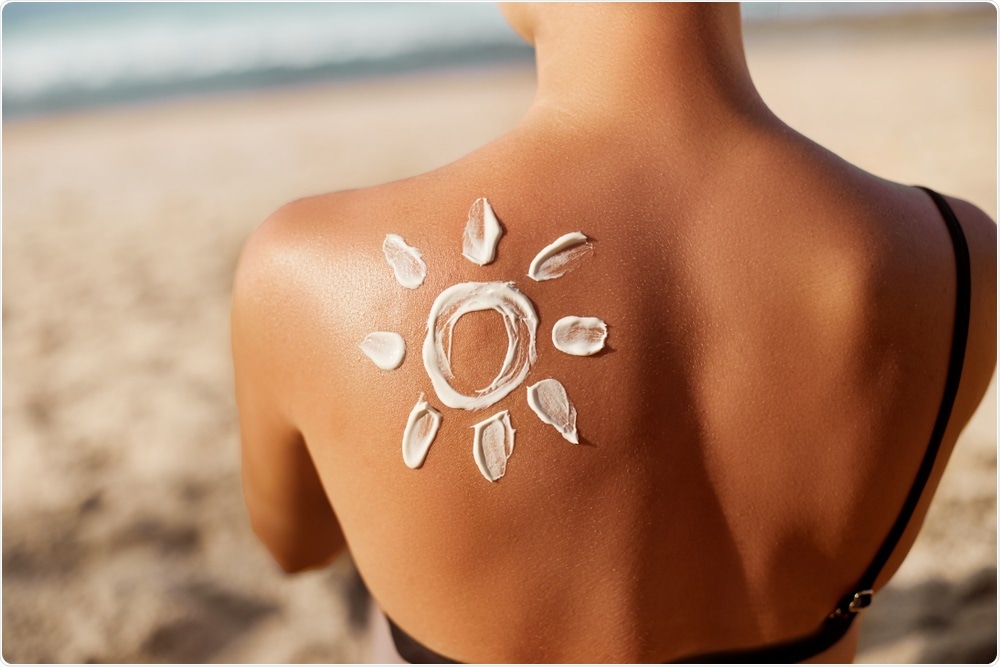New research using a sunscreen based on Methylene Blue has proven effective in protecting from UV irradiation as well as being safe for coral reefs, providing an alternative solution to protecting human skin and the environment.

Sunscreen. Image Credit: verona studio/Shutterstock.com
An alternative to coral-damaging and short-term sunscreen
80% of current sunscreens are harmful to corals as they contain Oxybenzone as a chemical UV blocker, a product known to detrimentally affect corals. In response, many countries have forbidden its use to limit the damage to coral reefs.
Additionally, the choice of sunscreen among consumers generally focuses on the Sunscreen Protecting Factor (SPF). However, SPF does not measure the broad spectrum of UV, as it only measures UVB exposure, which leaves sunscreen users vulnerable to UVA-triggered oxidative stress and photo-aging
In response to such limitations, a new study published in Nature Scientific Reports has found that Methylene Blue, a century-old medicine, has the potential to be a highly effective irradiation protector that absorbs both UVA and UVB, repairs reactive oxygen species (ROS produced due to oxidative damage) and UV irradiation-induced DNA damage, and does not negatively affect corals.
The study suggests that Methylene Blue could become an alternative sunscreen ingredient to Oxybenzone, effectively supporting the environment whilst providing protection for human skin health.
Parallel studies on human and coral health
The team of scientists from Mblue Labs and the University of Maryland led by senior author Dr. Kan Cao examined the UV protection benefits of Methylene Blue first from the human health perspective. Human keratinocytes and skin fibroblasts were considered from young and old donors and compared UV damage with Oxybenzone.
Results showed that Methylene Blue not only absorbs UVA and UVB as the traditional sunscreen actives do, it also helps repair the DNA damage caused by UV irradiation, leading to overall better cell survival.
In addition, the researchers also compared Methylene Blue with other skincare antioxidants such as Vitamin A (Retinol) and Vitamin C. This was to examine potential differences in their ability to reduce cellular oxidative stress which causes harmful ROS, contributing to the long-lasting effects of sunscreen application.
We are extremely excited to see that skin fibroblasts, derived from both young and old individuals, have improved so much in terms of proliferation and cellular stress in a methylene blue-containing cell culture medium.
We found that the combination of Methylene Blue and Vitamin C could deliver amazing anti-aging effects, particularly in skin cells from older donors, suggesting a strong synergistic reaction between these two beneficial antioxidants."
Dr. Cao
The team then investigated how corals responded to exposure to varying concentrations of Methylene Blue to determine how coral reefs could be affected. Researchers used the soft Red Sea Pom Pom Xenia Coral, Xenia umbellate, as study organisms. This species is found in the Red Sea and Southern tip of the African continent, areas with high levels of tourism-associated activities.
The coral individuals were kept in isolated tanks as researchers monitored the growth and responses to both Oxybenzone and Methylene Blue. The results showed Oxybenzone-treated Xenia corals suffered drastic bleaching and die-off in less than a week after exposure, while Methylene Blue exposure had no negative effects on coral health even at a relatively high concentration (1 micromolar).
A promising solution for promoting environmental and human health
Following the results of this study, researchers have already begun a patent application and have started developing sunscreen prototypes containing Methylene Blue. The potential for a sunscreen as effective in blocking UV irradiation across the UV spectrum and promoting DNA damage repair whilst providing environmentally secure products would not only support general human wellbeing but also tourist industries in coral reef areas.
Altogether, our study suggests that Methylene Blue has the potential to be a coral reef-friendly sunscreen active ingredient that can provide broad-spectrum protection against UVA and UVB”
Mblue Lab has recently launched the first multifunctional skincare product combining Methylene Blue and Vitamin C to optimize anti-aging effects. Previous research from the same team also focused on other skincare products using Methylene Blue, proving its diversity in applications.
Already, thanks to its enhancement of mitochondrial health and delaying of cell senescence, Methylene Blue has outperformed products such as MitoQ, NAC, and MTemp commonly found on the market. This is primarily thanks to the targeted benefits of Methylene Blue on skin hydration, dermis thickness expansion, and improvement of skin texture.
Future consideration into diversifying the applications of Methylene Blue across other products and benefits could further improve its effectiveness in terms of skincare. The consideration of environmental protection is also important as the increasing awareness of environmental damage is of central concern for ecosystems susceptible to human stress, including coral reefs.
As such, testing human-related products on organisms at ecologically relevant scales will become gradually more important to ensure the environmental footprint of products and activities are limited or avoided using alternative products such as Methylene Blue.
- Xiong, ZM., Mao, X., Trappio, M. et al. Ultraviolet radiation protection potentials of Methylene Blue for human skin and coral reef health. Sci Rep 11, 10871 (2021). https://doi.org/10.1038/s41598-021-89970-2
Posted in: Medical Science News | Medical Research News | Healthcare News
Tags: Aging, Cell, Cell Culture, DNA, DNA Damage, Hydration, Medicine, Methylene Blue, Oxidative Stress, Oxygen, Proliferation, Research, Retinol, Skin, Skin Cells, Stress, Vitamin A, Vitamin C

Written by
James Ducker
James completed his bachelor in Science studying Zoology at the University of Manchester, with his undergraduate work culminating in the study of the physiological impacts of ocean warming and hypoxia on catsharks. He then pursued a Masters in Research (MRes) in Marine Biology at the University of Plymouth focusing on the urbanization of coastlines and its consequences for biodiversity.
Source: Read Full Article
